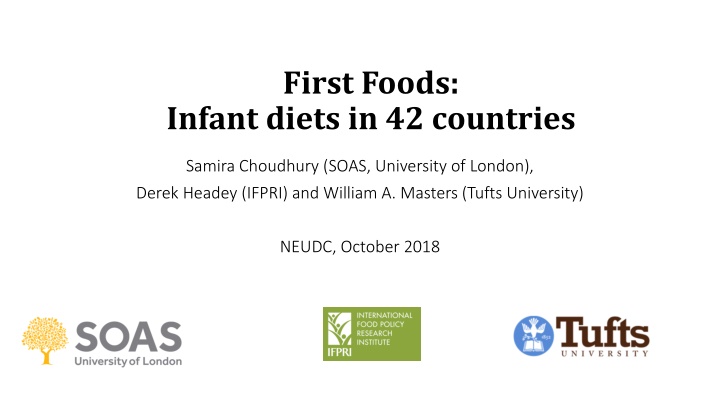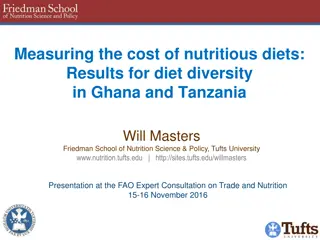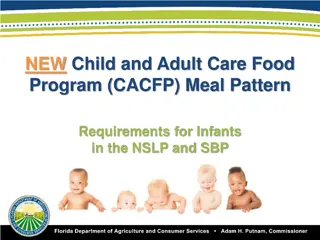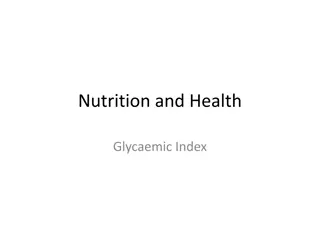Infant Diets in 42 Countries: Understanding Introduction of Solid Foods
This study explores infant feeding practices in 42 countries, emphasizing the gradual introduction of diverse and nutritious foods alongside continued breastfeeding. Analyzing data from Demographic and Health Surveys, the research aims to identify patterns in food introduction based on household and community characteristics to enhance infant feeding interventions and improve health outcomes.
Download Presentation

Please find below an Image/Link to download the presentation.
The content on the website is provided AS IS for your information and personal use only. It may not be sold, licensed, or shared on other websites without obtaining consent from the author.If you encounter any issues during the download, it is possible that the publisher has removed the file from their server.
You are allowed to download the files provided on this website for personal or commercial use, subject to the condition that they are used lawfully. All files are the property of their respective owners.
The content on the website is provided AS IS for your information and personal use only. It may not be sold, licensed, or shared on other websites without obtaining consent from the author.
E N D
Presentation Transcript
First Foods: Infant diets in 42 countries Samira Choudhury (SOAS, University of London), Derek Headey (IFPRI) and William A. Masters (Tufts University) NEUDC, October 2018
Motivation Infants need gradual introduction of diverse, nutritious foods from 6 months of age, in addition to continued breastfeeding Growth faltering and micronutrient deficiencies are most acute from 6 to 23 months, with lifelong and often irreversible consequences for health and productivity Actual observation of which solid foods are introduced has been limited by small number of infants at each age in months Identifying patterns in the introduction of new foods by household and community characteristics could guide intervention to improve infant feeding
Motivation Figure 1. Child growth faltering and anemia, by age in months Prevalence Anemia Stunting Notes: Stunting (HAZ<-2) and anemia (hemoglobin<11 g/dl), among 67,241 children measured for Phase 5 & 6 of the DHS in 39 countries where hemoglobin tests were done.
Theory and study design Previous work on other kinds of food consumption have revealed -- Income effects: demand for diversity, and for preferred foods -- Limited knowledge of health effects, and diverse preferences -- Non-separability between production and consumption due to missing markets Using recent DHS surveys merged with geographic data, we can test how the gradual introduction of new foods is linked to -- Household wealth, maternal and paternal education and health care utilization -- Agroecological conditions and market infrastructure around survey locations Outcomes are nutritional measures of diet quality, as diversity among food groups and prevalence of intake from each group in the previous 24 hours
Data Demographic and Health Surveys (DHS) data from Phase 5 and 6 modules, asking mothers whether the child was fed each item from a standardized list -- 76,641 children from 42 countries, in 52 surveys from 2006 to 2013 -- other DHS data on household assets, parental education, and health behavior -- merged with GIS data on agro-ecology and infrastructure around the survey site Diet quality measures are: -- Diet diversity score (DDS) number out of 7 broad food groups -- Minimum dietary diversity (MDD) indicator for 4 of the 7 groups -- Intake of specific nutrient-dense foods from 10 narrower categories
Each food group provides different nutrients Food group classifications used for WHO/UNICEF indicators of infant diet quality Food groups used for dietary diversity scores and minimum diet diversity Disaggregated food categories used for analysis of nutrient-rich food consumption Starchy staples Cereals (excluded) Roots/tubers (excluded) Legumes and nuts Vitamin A-rich fruits and vegetables, excluding DGLV DGLV (Dark green leafy vegetables) Other fruits and vegetables Legumes and nuts Vitamin A-rich fruits and vegetables Other fruits and vegetables Dairy products Dairy products Eggs Eggs Meat, organs, fish Meat/organs Fish
New food groups are added too slowly for infant needs, especially in poorer households Mean child diversity score at each age in months, by wealth tercile Dietary diversity score (0-7 food groups) 7 6 5 Minimum diet diversity threshold Richest tercile 4 Middle tercile 3 Poorest tercile 2 1 What accounts for this variation in meeting infant needs? 0 0 6 12 18 24 Child age (months) Poorest wealth tercile Middle wealth tercile Richest wealth tercile 95% CI 95% CI 95% CI
Most but not all food groups are more widely consumed by infants in richer households Fraction of children consuming each food group in previous 24 hrs, by wealth tercile 100% Poorest tercile Middle tercile Richest tercile 80% 60% 40% 20% 0%
Infant feeding patterns differ by region Dietary diversity and intake of specific foods at 6-23 months of age, by region Lower intake in Africa & Asia than elsewhere DDS (1-7) MDD ( 4) DGL veg VA-rich fruit, veg Other fruit, veg Legumes & nuts Dairy Eggs Meat Fish Sub-Saharan Africa Asia E. Europe & Central Asia L. America & the Caribbean Mideast & North Africa Total 2.3 22.1% 32.2% 14.9% 17.5% 24.5% 24.4% 11.7% 17.2% 24.6% 2.6 28.2% 42.0% 13.6% 21.4% 18.2% 28.7% 22.9% 21.4% 22.6% 3.1 45.2% 13.0% 18.9% 46.6% 15.4% 65.2% 37.0% 40.1% 3.7% 4.0 63.9% 17.6% 39.9% 47.5% 40.4% 64.0% 41.7% 55.8% 11.4% 3.6 56.3% 18.0% 10.5% 46.2% 28.4% 83.4% 46.5% 38.7% 14.4% 2.8 35.2% 28.3% 20.1% 27.6% 27.3% 39.2% 22.8% 28.5% 20.4%
We aim to distinguish wealth and preferences from agro-ecological and infrastructure effects OLS & linear probability models of the form: ??,?,?= ????,?,?+ ????,?+ ???,?,?+ ??+ ??,?,? D = Diet diversity score, and minimum diet diversity (DDS, MDD) or consumption of each food group (yes/no) H = Household factors (income, education, healthcare utilization) C = Community factors (agroecology and infrastructure) Z = child age in months ? = country-year fixed effects ? = error term
We find strong links with wealth and education Association of infant diet diversity with household and community factors Panel 1 of 3: Wealth and education DDS (1-7) MDD ( 4) 6-23 mo. 12-23 mo. 6-23 mo. 12-23 mo. Household wealth (terciles) middle vs low high vs low Maternal education (years) 1-6 yrs vs none 7-9 yrs vs none 10+ yrs vs none Paternal education (years) 1-6 yrs vs none 7-9 yrs vs none 10+ yrs vs none 0.146*** 0.365*** 0.171*** 0.424*** 0.043*** 0.100*** 0.055*** 0.123*** 0.127*** 0.284*** 0.448*** 0.160*** 0.324*** 0.518*** 0.026*** 0.070*** 0.108*** 0.038*** 0.095*** 0.133*** 0.097*** 0.141*** 0.183*** 0.113*** 0.151*** 0.207*** 0.016*** 0.026*** 0.042*** 0.022*** 0.030*** 0.051***
and further links with community factors Association of infant diet diversity with household and community factors Panel 2 of 3: Healthcare and infrastructure DDS (1-7) MDD ( 4) 6-23 mo. 12-23 mo. 6-23 mo. 12-23 mo. Health behavior Healthcare utilization vs none Child breastfed immediately vs not Gender bias? Mother decides own healthcare vs not Child sex is male vs female Infrastructure and market access Night lights intensity, middle vs low Night lights intensity, high vs low Population density, middle vs low Population density, high vs low Distance to coastline, middle vs low Remote location vs not remote 0.0218*** 0.034*** 0.179*** 0.051*** 0.074*** 0.013*** 0.051*** 0.016*** 0.006 -0.002 0.000 -0.004 -0.006 0.001 -0.005 -0.001 0.055** 0.143*** 0.045** 0.048* 0.030 -0.031 0.056* 0.180*** 0.045** 0.054* 0.087*** -0.030 0.012* 0.031*** 0.011** 0.013* 0.014** -0.009* 0.017** 0.043*** 0.010 0.014* 0.023*** -0.007
and also with local agroecology Association of infant diet diversity with household and community factors Panel 3 of 3: Geography and agroecology DDS (1-7) MDD ( 4) 6-23 mo. 12-23 mo. 6-23 mo. 12-23 mo. Geography (continued) Dist. to coastline, high vs low Dist. to water body, middle vs low Dist. to water body, high vs low Agroecology Mean rainfall, middle vs low Mean rainfall, high vs low Mean temperature, middle vs low Mean temperature, high vs low Altitude by cluster, middle vs low Altitude by cluster, high vs low R-squared Number of observations -0.013 0.030* 0.028 0.020 0.025 0.014 0.003 0.009** 0.007 0.004 0.011* 0.005 0.122*** 0.120*** -0.108*** -0.153*** 0.031 0.011 0.356 76641 0.142*** 0.111*** -0.120*** -0.137*** 0.023 0.014 0.311 49123 0.020*** 0.014** -0.030*** -0.042*** 0.004 -0.002 0.255 76641 0.026*** 0.016* -0.039*** -0.039*** 0.005 0.002 0.251 49123
Nutritionists are especially concerned about micronutrients in dark green leafy and vitamin-A rich (orange) fruits & vegetables Association of individual vegetal foods intake with household and community factors Panel 1 of 3: Wealth and education Dark green leafy veg Vit.A-rich fruit, veg Other fruit, veg Legumes & nuts Household wealth middle vs low high vs low Maternal education -0.016*** -0.009 0.013*** 0.056*** 0.021*** 0.057*** 0.016*** 0.010 1-6 yrs vs none -0.007 0.006 0.016*** 0.019*** 7-9 yrs vs none 0.010 0.029*** 0.047*** 0.037*** 10+ yrs vs none Paternal education 0.029*** 0.057*** 0.076*** 0.034*** 1-6 yrs vs none 0.006 0.007 0.005 0.029*** 7-9 yrs vs none 0.008 0.017*** 0.017*** 0.014** 10+ yrs vs none 0.014** 0.024*** 0.024*** 0.015***
Nutritionists are especially concerned about micronutrients in dark green leafy and vitamin-A rich (orange) fruits & vegetables Association of individual vegetal foods intake with household and community factors, cont d. Panel 2 of 3: Healthcare and infrastructure Dark green leafy veg Vit.A-rich fruit, veg Other fruit, veg Legumes & nuts Health behavior Healthcare utilization vs none Child breastfed immediately vs not Gender bias? Mother decides own healthcare vs not Child sex is male vs female Infrastructure and market access Night lights intensity, middle vs low Night lights intensity, high vs low Population density, middle vs low Population density, high vs low Distance to coastline, middle vs low Remote location vs not remote DGLV demand is different from demand for other vegetal foods -0.002 0.003 0.024*** 0.007** 0.048*** 0.008** 0.012*** 0.009** 0.009** 0.000 -0.005 0.000 -0.005 0.002 0.003 -0.001 -0.005 0.000 0.005 0.01 0.004 -0.006 0.017** 0.009 0.008 0.023*** 0.006 -0.012** 0.001 0.016** 0.024*** 0.026*** -0.012** -0.011** -0.017*** -0.005 0.004 0.009 0.010* 0.002
Nutritionists are especially concerned about micronutrients in dark green leafy and vitamin-A rich (orange) fruits & vegetables Association of individual vegetal foods intake with household and community factors, cont d. Panel 3 of 3: Geography and agroecology Dark green leafy veg Vit.A-rich fruit, veg Other fruit, veg Legumes & nuts Geography (continued) Dist. to coastline, high vs low Dist. to water body, middle vs low Dist. to water body, high vs low Agroecology Mean rainfall, middle vs low Mean rainfall, high vs low Mean temperature, middle vs low Mean temperature, high vs low Altitude by cluster, middle vs low Altitude by cluster, high vs low R-squared Number of observations 0.075*** 0.023*** 0.029*** -0.016* 0.014*** 0.012** -0.022*** 0.011** -0.004 0.007 0.007 0.020*** 0.008 -0.015* -0.028*** -0.058*** 0.014** 0.022*** 0.169 76641 0.007 -0.012 -0.043*** -0.057*** 0.007 -0.013 0.144 76641 0.033*** 0.033*** -0.009 -0.030*** 0.006 0.008 0.183 76641 0.031*** 0.030*** -0.020*** -0.044*** 0.005 0.033*** 0.154 76641
Animal sourced foods may be especially important for nutrition in early infancy Association of individual animal foods intake with household and community factors Panel 1 of 3: Wealth and education Dairy Eggs Meat Fish Household wealth middle vs low high vs low Maternal education 1-6 yrs vs none 7-9 yrs vs none 10+ yrs vs none Paternal education 1-6 yrs vs none 7-9 yrs vs none 10+ yrs vs none 0.041*** 0.131*** 0.028*** 0.057*** 0.031*** 0.086*** 0.011*** 0.000 0.014*** 0.064*** 0.114*** 0.016*** 0.033*** 0.055*** 0.009** 0.036*** 0.077*** 0.041*** 0.037*** 0.032*** -0.005 0.019*** 0.028*** 0.015*** 0.023*** 0.032*** 0.005 0.021*** 0.020*** 0.028*** 0.043*** 0.006
Animal sourced foods may be especially important for nutrition in early infancy Association of individual animal foods intake with household and community factors, cont d. Panel 2 of 3: Healthcare and infrastructure Dairy Eggs Meat Fish Health behavior Healthcare utilization vs none Child breastfed immediately vs not Gender bias? Mother decides own healthcare vs not Child sex is male vs female Infrastructure and market access Night lights intensity, middle vs low Night lights intensity, high vs low Population density, middle vs low Population density, high vs low Distance to coastline, middle vs low Remote location vs not remote 0.053*** -0.006 0.052*** 0.017*** 0.050*** 0.012*** 0.006 0.009*** -0.016*** 0.007** 0.001 -0.004 -0.003 0.000 0.006* 0.000 0.027*** 0.069*** -0.007 0.000 0.014** 0.012** 0.007 0.029*** -0.004 -0.005 0.011** -0.005 0.029*** 0.050*** 0.015*** 0.006 0.019*** -0.007 0.007 -0.001 -0.012** -0.026*** -0.013** -0.009*
Animal sourced foods may be especially important for nutrition in early infancy Association of individual animal foods intake with household and community factors, cont d. Panel 3 of 3: Geography and agroecology Dairy Eggs Meat Fish Geography (continued) Dist. to coastline, high vs low Dist. to water body, middle vs low Dist. to water body, high vs low Agroecology Mean rainfall, middle vs low Mean rainfall, high vs low Mean temperature, middle vs low Mean temperature, high vs low Altitude by cluster, middle vs low Altitude by cluster, high vs low R-squared Number of observations 0.023** -0.002 -0.004 -0.020*** 0.011*** 0.010** 0.017** 0.008* 0.015*** -0.037*** -0.042*** -0.052*** -0.044*** -0.064*** -0.009 -0.008 -0.009 0.001 0.276 76641 0.021*** 0.044*** -0.017*** -0.020** 0.021*** 0.028*** 0.187 76641 0.022*** 0.022*** -0.001 0.024*** 0.013** -0.032*** 0.232 76641 0.045*** 0.099*** 0.025*** 0.051*** -0.045*** -0.057*** 0.163 70137
Conclusion First global study linking individual infants intake to both household and geographical factors 76,641 children aged 6-23 months, from 42 countries surveyed in 2006-2013 Strong support for differences in demand at each location An infant-feeding version of Bennett s Law Stronger links to mother s education than father s education Clear links to differences in cost at each location Climate change towards hotter and drier weather could worsen diet quality Controlling for other factors, night lights most closely linked to dairy and meat Results provide observational baseline to guide intervention Nutrition-smart policies are needed for earlier diversification of children s diets and the small number of infants at each age and location makes research very challenging!
Thank you! This work was funded by grant OPP1112307 from the Bill & Melinda Gates Foundation, as part of the project on Advancing Research on Nutrition and Agriculture (ARENA)























